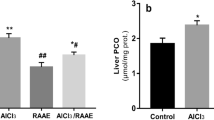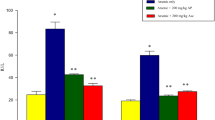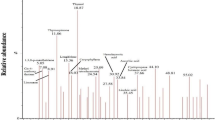Abstract
The present study was planned to investigate the protective effects of Nigella sativa oil (NSO) supplementation against aluminium chloride (AlCl3)-induced oxidative damage in liver and erythrocytes of rats. Simultaneously, a preliminary phytochemical study was affected in order to characterize the bioactive components containing in the NSO using chemical assays. The antioxidant capacities of NSO were evaluated by DPPH assay. The results showed that NSO was found to contain large amounts of total phenolics, flavonoids and tannins. Twenty-four rats were equally divided into two groups, in which group A received standard diet, whereas group B treated daily with an oral gavage dose of 2 ml NSO/kg body weight. After 5 weeks pretreatment, both groups were divided again into two subgroups (A and B) of six animals each and treated for other 3 weeks. Therefore, subgroup A1 was served as a control which received standard diet, but subgroup A2 received AlCl3 (34 mg/kg bw mixed with food). Subgroup B1 received both AlCl3 and NSO; however, subgroup B2 received NSO only. Results showed that AlCl3 exhibited an increase in white blood cell counts and a marked decrease in erythrocyte counts and haemoglobin content. Plasma aspartate transaminase, alanine transaminase, alkaline phosphatase and lactate dehydrogenase activities and total bilirubin concentration were higher in AlCl3 group than those of the control, while albumin and total protein concentration were significantly lower. Compared to the control, a significant raise of hepatic and erythrocyte malondialdehyde level associated with a decrease in reduced glutathione content, glutathione peroxidase, superoxide dismutase and catalase, activities of AlCl3 treated rats. However, the administration of NSO alone or combined with AlCl3 has improved the status of all parameters studied. It can be concluded that AlCl3 has induced the oxidative stress, altered the biochemical parameters and the hepatic histological profile, but the supplementation of NSO has alleviated such toxicity.



Similar content being viewed by others
References
Kumar V, Bal A, Gill K (2009) Susceptibility of mitochondrial superoxide dismutase to aluminium induced oxidative damage. Toxicology 255:117–123
Guo C, Hsu GW, Chuang C, Chen P (2009) Aluminium accumulation induced testicular oxidative stress and altered selenium metabolism in mice. Environ Toxicol Pharmacol 27:176–181
González MA, Roma M, Bernal C, Alvarez ML, Carrillo MC (2007) Involvement of oxidative stress in the impairment in biliary secretory function induced by chronic administration of aluminum to rats. Biol Trace Elem Res 116:329–348
González MA, Bernal CA, Mahieu S, Carrillo MC (2009) The interactions between the chronic exposure to aluminum and liver regeneration on bile flow and organic anion transport in rats. Biol Trace Elem Res 127:164–176
El-Demerdash FM (2004) Antioxidant effect of vitamin E and selenium on lipid peroxidation, enzyme activities and biochemical parameters in rats exposed to aluminium. J Trace Elem Med Biol 18:113–121
Turkez H, Yousef MI, Geyikoglu F (2010) Propolis prevents aluminium-induced genetic and hepatic damages in rat liver. Food Chem Toxicol 48:2741–2746
Yousef MI (2004) Aluminium-induced changes in hemato-biochemical parameters, lipid peroxidation and enzyme activities of male rabbits: protective role of ascorbic acid. Toxicology 199:47–57
Newairy AS, Salama AF, Hussien HM, Yousef MI (2009) Propolis alleviates aluminium induced lipid peroxidation and biochemical parameters in male rats. Food Chem Toxicol 47:1093–1098
Kaneko N, Takada J, Yasui H, Sakurai H (2006) Memory deficit in mice administered aluminum–maltolate complex. Biometals 19:83–89
Mahdy KA, Farrag ARH (2009) Amelioration of aluminium toxicity with black seed supplement on rats. Toxicol Environ Chem 91:567–579
Lukyanenko LM, Skarabahatava AS, Slobozhanina EI, Kovaliova SA, Falcioni ML (2013) In vitro effect of AlCl3 on human erythrocytes: changes in membrane morphology and functionality. J Trace Elem Med Biol 27:160–167
Tacke F, Luedde T, Trautwein C (2009) Inflammatory pathways in liver homeostasis and liver injury. Clin Rev Allergy Immunol 36:4–12
Nazıroğlu M, Karaoğlu A, Orhan Aksoy A (2004) Selenium and high dose vitamin E administration protects cisplatin-induced oxidative damage to renal, liver and lens tissues in rats. Toxicology 195:221–230
Nazıroğlu M, Kozlu S, Yorgancıgil E, Uğuz AC, Karakuş K (2013) Protective effects of rose oil (Rosa damascena Mill) vapor on depression-induced oxidative stress in rat brain. J Nat Med 67(1):152–158
Messarah M, Amamra W, Boumendjel A, Barket L, Bouasla I, Abdennour C, Boulakoud MS, El-Feki A (2012) Ameliorating effects of curcumin and vitamin E on diazinon induced oxidative damage in rat liver and erythrocytes. Toxicol Ind Health 29:1–12
Mahmoud MR, El-Abhar HS, Salech S (2002) The effect of Nigella sativa oil against the liver damage induced by Schistosoma mansoni infection in mice. J Ethnopharmacol 79:1–11
Yaman I, Balikci E (2010) Protective effects of Nigella sativa against gentamicin induced nephrotoxicity in rats. Exp Toxicol Pathol 62:183–190
Krishnan N, Muthukrishnan S (2012) Effects of Nigella sativa seed extract on carbon tetrachloride induced hepatotoxicity in rats. J Acute Med 2:107–113
Mohamadin AM, Sheikh B, Abd El-Aal AA, Elberry AA, Al Abbasi FA (2010) Protective effects of Nigella sativa oil on propoxur induced toxicity. Pest Biochem Physiol 98:128–134
Cheikh-Rouhou S, Besbes S, Blecker C, Deroanne C, Attia H (2007) Nigella sativa L.: chemical composition and physicochemical characteristics of lipid fraction. Food Chem 101:673–681
Bourgou S, Ksouri R, Bellila A, Skandran I, Falleh H, Marzouk B (2008) Phenolic composition and biological activities of Tunisian Nigella sativa L shots and roots. C Biol 331:48–55
Wolfe K, Wu X, Liu RH (2003) Antioxidant activity of apple peals. J Agric Food Chem 51:609–614
Blois MS (1958) Antioxidant determinations by the use of stable free radical. Nature 26:1199–1200
Yen GC, Chen HY (1995) Antioxidant activity of various tea extracts in relation to their antimutagenicity. J Agric Food Chem 43:27–32
Zhishen J, Mengcheng T, Jianming W (1999) The determination of flavonoid contents in mulberry and their scavenging effects on superoxide radicals. Food Chem 64:555–559
Julkunen-Tiitto R (1985) Phenolics constituents in the leaves of northern willows: methods for the analysis of certain phenolics. J Agric Food Chem 33:213–217
Kokdil G, Tamer L, Ercan B, Ilcim A, Aras N, Atik U (2005) Effects of Nigella unguicularis fixed oil on blood biochemistry and oxidant/antioxidant balance in rats. J Ethnopharmacol 99:131–135
Buege JA, Aust SD (1984) Microsomal lipid peroxidation. Methods Enzymol 105:302–310
Jollow DJ, Mitchel JR, Zamppaglione Z, Gillette JR (1974) Bromobenzene induced liver necrosis. Protective role of glutathione and evidence for 3,4-bromobenzene oxide as the hepatotoxic metabolites. Pharmacology 11:51–57
Flohe L, Gunzler WA (1984) Analysis of glutathione peroxidase. Methods Enzymol 105:114–121
Aebi H (1984) Catalase in vitro. Method Enzymol 105:121–126
Asada K, Takahashi M, Nagate M (1974) Assay and inhibitors of spinach superoxide dismutase. Agric Biol Chem 38:471–473
Bradford M (1976) A rapid and sensitive method for the quantities of microgram quantities of protein utilizing the principale of protein binding. Anal Biochem 72:248–254
Hould R (1984) Techniques d’histopathologie et de cytopathologie. Ed Maloine 19–21:225–227
Mariod AA, Ibrahim RM, Ismail M, Ismail N (2009) Antioxidant activity and phenolic content of phenolic rich fraction obtained from black cumin (Nigella sativa) seedcake. Food Chem 116:306–312
Mahieu S, Millen N, Gonzelez M, Contini MDC, Elias MM (2005) Alteration of the renal function and oxidative stress in renal tissue from rats chronically treated with aluminium during the initial phase of hepatic regeneration. J Inorg Biochem 99:1858–1864
Zhu Y, Li X, Chen C, Wang F, Li J, Hu C, Li Y, Miao L (2012) Effects of aluminium trichloride on the trace elements and cytokines in the spleen of rats. Food Chem Toxicol 50:2911–2915
Farina M, Ratta LN, Soares FAA, Jardim F, Jacques R, Souza DO, Rocha JBT (2005) Haematological changes in rats chronically exposed to oral aluminium. Toxicology 209:29–37
Salem ML (2005) Review: Immunomodulatory and therapeutic properties of the Nigella sativa L. seed. Int Immunopharmacol 5:1749–1770
Meral I, Kanter M (2003) Effects of Nigella sativa L and Uritica sioica L on selected mineral status and haematological values in CCl4-treated rats. Biol Trace Elem Res 96:263–270
Shrivastava S (2012) Combined effect of HEDTA and selenium against aluminium induced oxidative stress in rat brain. J Trace Elem Med Biol 26:210–214
Nehru B, Anand P (2005) Oxidative damage following chronic aluminium exposure in adult and pup rat brains. J Trace Elem Med Biol 19:203–208
Wu Z, Du Y, Xue H, Wu Y, Zhou B (2012) Aluminium induces neurodegeneration and its toxicity arises from increased iron accumulation and reactive oxygen species (ROS) production. Neurobiol Aging 33:1–12
Acknowledgments
The present research was supported by the Algerian Ministry of Higher Education and Scientific Research, Directorate General for Scientific Research and Technological Development through the Research Laboratory “Laboratory of Biochemical and Environmental Toxicology” Faculty of Sciences, University of Badji Mokhtar, Annaba, Algeria.
Conflict of Interest
The authors declare that there are no conflicts of interest.
Author information
Authors and Affiliations
Corresponding author
Rights and permissions
About this article
Cite this article
Bouasla, I., Bouasla, A., Boumendjel, A. et al. Nigella sativa Oil Reduces Aluminium Chloride-Induced Oxidative Injury in Liver and Erythrocytes of Rats. Biol Trace Elem Res 162, 252–261 (2014). https://doi.org/10.1007/s12011-014-0114-5
Received:
Accepted:
Published:
Issue Date:
DOI: https://doi.org/10.1007/s12011-014-0114-5




